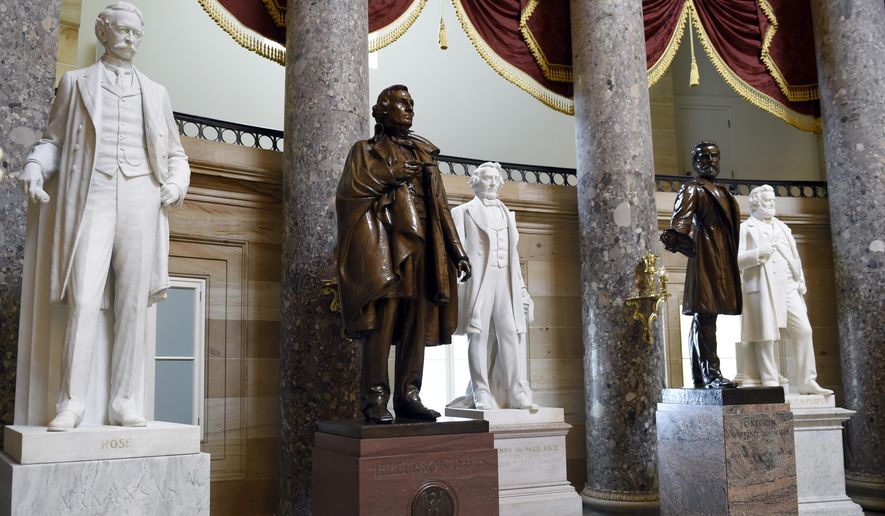House Speaker Nancy Pelosi wants to remove 11 statues with links to the Confederacy from the halls of Congress, an idea that so far has met little resistance from Republicans or anyone else.
While some argue that taking down the statues ensures that the nation’s past issues with racism aren’t glorified, others maintain doing so would be an attempt to deny history, flawed though it may be.
Here are some of the figures from history likely on the list to be sacked, along with the date they were installed and their descriptions, as provided by the Architect of the Capitol.
Jefferson Davis, Mississippi (1931) — Davis served the nation in many positions before being appointed president of the Confederate States during the Civil War, including secretary of war, a member of the House of Representatives and a member of the Senate.
Alexander Hamilton Stephens, Georgia (1927) — Stephens was opposed to secession and differed with Davis over states’ rights and nullification, but nevertheless served as the Confederacy’s vice president. President Abraham Lincoln’s trust in Stephens led to the Hampton Roads Peace Conference, which was unsuccessful. At the close of the war, Stephens was arrested and imprisoned for five months at Fort Warren in Boston Harbor.
Robert E. Lee, Virginia (1909) — When the South seceded, Lee reluctantly resigned from the Army, hoping to avoid participation in the war he deplored. However, a sense of duty to his state convinced him to accept command of the Virginia forces.
Joseph Wheeler, Alabama (1925) — An 1859 graduate of the U.S. Military Academy, he resigned from the Army to join the Confederate forces in 1861 and rose rapidly to the rank of lieutenant general. Nicknamed “Fighting Joe,” Wheeler was considered by Lee to be one of the two most outstanding Confederate cavalry leaders and saw action in many campaigns, including the opposition to Gen. William Tecumseh Sherman’s advance on Atlanta. He served in the House of Representatives from 1881-1883 and 1885-1900; there he strove to heal the breach between the North and the South and championed economic policies that would help the South.
James Zachariah George, Mississippi (1931) — In 1854 he became a reporter of the Supreme Court of Mississippi, and over the next 20 years he prepared a 10-volume digest of its cases. As a member of the Mississippi Secession Convention, he signed the Ordinance of Secession. A Confederate colonel during the Civil War, he was captured twice and spent two years in prison, where he conducted a law course for his fellow prisoners.
Wade Hampton, South Carolina (1929) — Elected in 1852 to the South Carolina legislature from Richland County, he served until 1856; he then served in the state Senate until he resigned in 1861. Though he had not favored secession, he supported the Confederacy from the outset.
He was involved in many major battles, including Gettysburg. Hampton was promoted to major general in 1863 and lieutenant general in 1865.
Edmund Kirby Smith, Florida (1922) — In 1861, Smith resigned from the U.S. Army to join the Confederate forces. He was commissioned colonel of the cavalry and rose to the rank of general. While commanding a brigade in the army, he was severely wounded at Manassas. From 1863 until the end of the war he commanded the Trans-Mississippi Department. He surrendered the last military force of the Confederacy.
Zebulon Vance, North Carolina (1916) — Though he supported the constitutionality of secession, he was an ardent Unionist, not favoring secession until President Lincoln called for troops in 1861. He then organized and served with the Rough and Ready Guards.
Elected governor in 1862, he worked during the war to ensure legality in the harsh conscription practices of the Confederacy and to guarantee protection of the law to North Carolinians.
John E. Kenna, West Virginia (1901) — He had little education, and at the age of 16 he served with General Shelby in the Confederate Army and was wounded. After returning home, he read law and was admitted to the bar in 1870. He became very active in the emerging Democratic Party of West Virginia.
Douglas White, Louisiana (1955) — He was educated at Mount St. Mary’s College in Emmitsburg, Maryland; at Jesuit College in New Orleans; and at Georgetown College (now University) in Washington, D.C. In 1861 he left school and enlisted in the Confederate Army. After the war he studied law, and in 1868 he was admitted to the bar. He served in the state Senate from 1874 to 1879 and on the Louisiana Supreme Court from 1879 to 1880.
Uriah Milton Rose, Arkansas (1917) — In 1860 he was appointed chancellor in Pulaski County, a position he held until Union forces captured the state capital. Although he opposed secession, he remained loyal to Arkansas throughout the Civil War. Moving to Little Rock in 1865, he formed a partnership with George C. Watkins, former chief justice of Arkansas. Two years later he published the Digest of the Arkansas Reports.
• Gabriella Muñoz can be reached at gmunoz@washingtontimes.com.




Please read our comment policy before commenting.